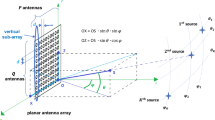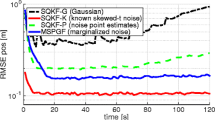Abstract
Passive source localization via a maximum likelihood (ML) estimator can achieve a high accuracy but involves high calculation burdens, especially when based on time-of-arrival and frequency-of-arrival measurements for its internal nonlinearity and nonconvex nature. In this paper, we use the Pincus theorem and Monte Carlo importance sampling (MCIS) to achieve an approximate global solution to the ML problem in a computationally efficient manner. The main contribution is that we construct a probability density function (PDF) of Gaussian distribution, which is called an important function for efficient sampling, to approximate the ML estimation related to complicated distributions. The improved performance of the proposed method is attributed to the optimal selection of the important function and also the guaranteed convergence to a global maximum. This process greatly reduces the amount of calculation, but an initial solution estimation is required resulting from Taylor series expansion. However, the MCIS method is robust to this prior knowledge for point sampling and correction of importance weights. Simulation results show that the proposed method can achieve the Cramér-Rao lower bound at a moderate Gaussian noise level and outperforms the existing methods.
Similar content being viewed by others
References
Alizadeh, F., Goldfarb, D., 2003. Second-order cone programming. Math. Prog., 95(1): 3–51. https://doi.org/10.1007/s10107-002-0339-5
Beck, A., Stoica, P., Li, J., 2008. Exact and approximate solutions of source localization problems. IEEE Trans. Signal Process., 56(5): 1770–1778. https://doi.org/10.1109/TSP.2012.2191778
Broyden, C.G., 1970. The convergence of a class of doublerank minimization algorithms 1: general considerations. IMA J. Appl. Math., 6(1): 76–90. https://doi.org/10.1093/imamat/6.1.76
Chan, Y.T., Hang, H.Y.C., Ching, P.C., 2006. Exact and approximate maximum likelihood localization algorithms. 55(1): 10–16. https://doi.org/10.1109/TVT.2005.861162
Cheung, K.W., So, H.C., Ma, W.K., et al., 2004. Least squares algorithms for time-of-arrival-based mobile location. IEEE Trans. Signal Process., 52(4): 1121–1130. https://doi.org/10.1109/TSP.2004.823465
Coleman, T.F., Li, Y., An, I., 2006. Trust region approach for nonlinear minimization subject to bounds. SIAM J. Optim., 6(2): 418–445. https://doi.org/10.1137/0806023
Dong, L., 2012. Cooperative localization and tracking of mobile ad hoc networks. IEEE Trans. Signal Process., 60(7): 3907–3913. https://doi.org/10.1109/TSP.2012.2191778
Elvira, V., Martino, L., Luengo, D., et al., 2016. Heretical multiple importance sampling. IEEE Signal Process. Lett., 23(10): 1474–1478. https://doi.org/10.1109/LSP.2016.2600678
Engel, U., 2009. A geolocation method using TOA and FOA measurements. positioning, navigation and communication. IEEE Workshop on Positioning, p.77–82. https://doi.org/10.1109/WPNC.2009.4907807
Fletcher, R., Reeves, C.M., 1964. Function minimization by conjugate gradients. Comput. J., 7(2): 149–154. https://doi.org/10.1090/S0025.5718.1970.0274029.X
Foy, W.H., 1976. Position-location solutions by Taylor-series estimation. IEEE Trans. Aerosp. Electron. Syst., AES-12(2):187–194. https://doi.org/10.1109/TAES.1976.308294
Fu, Z., Sun, X., Liu, Q., et al., 2015. Achieving efficient cloud search services: multi-keyword ranked search over encrypted cloud data supporting parallel computing. IEICE Trans. Commun., 98(1): 190–200. https://doi.org/10.1109/TSP.2012.2191778
Gu, B., Sun, X., Sheng, V.S., 2017. Structural minimax probability machine. IEEE Trans. Neur. Netw. Learn. Syst., 28(7): 1646–1656. https://doi.org/10.1109/TNNLS.2016.2544779
Huang, J.G., Xie, D., Li, X., et al., 2006. Maximum likelihood DOA estimator based on importance sampling. IEEE Region 10 Conf., p.1–4. https://doi.org/10.1109/TENCON.2006.344051
Kay, S.M., 1993. Fundamentals of Statistical Signal Processing, Volume I: Estimation Theory. Prentice-Hall, London, p.111–136.
Kay, S.M, 2006. Intuitive Probability and Random Processes Using MATLAB. Springer, Berlin. https://doi.org/10.1007/b104645
Knapp, C., Carter, G., 1976. The generalized correlation method for estimation of time delay. IEEE Trans. Acoust. Speech Signal Process., 24(4): 320–327. https://doi.org/10.1109/TASSP.1976.1162830
Ma, Z., Ho, K.C., 2011. TOA localization in the presence of random sensor position errors. IEEE Int. Conf. on Acoustics, Speech and Signal Processing, p.2468–2471. https://doi.org/10.1109/ICASSP.2011.5946984
Masmoudi, A., Bellili, F., Affes, S., et al., 2013. A maximum likelihood time delay estimator in a multipath environment using importance sampling. IEEE Trans. Signal Process., 61(1): 182–193. https://doi.org/10.1109/TSP.2012.2222402
Pan, Z., Lei, J., Zhang, Y., et al., 2016. Fast motion estimation based on content property for low-complexity H.265/HEVC encoder. IEEE Trans. Broadcast., 62(3): 1–10. https://doi.org/10.1109/TBC.2016.2580920
Papakonstantinou, K., Slock, D., 2009. Hybrid TOA/AOD/Doppler-shift localization algorithm for NLOS environments. Int. Symp. on Personal, Indoor and Mobile Radio Communications, p.1948–1952. https://doi.org/10.1109/PIMRC.2009.5450008
Patwari, N., Ash, J.N., Kyperountas, S., et al., 2005. Locating the nodes: cooperative localization in wireless sensor networks. IEEE Signal Process. Mag., 22(4): 54–69. https://doi.org/10.1109/MSP.2005.1458287
Pincus, M., 1968. A closed form solution of certain programming problems. Oper. Res., 16(3): 690–694. https://doi.org/10.1287/opre.16.3.690
Ramlall, R., Chen, J., Swindlehurst, A.L., 2014. Non-line-ofsight mobile station positioning algorithm using TOA, AOA, and Doppler-shift. Ubiquitous Positioning Indoor Navigation and Location Based Service, p.180–184. https://doi.org/10.1109/UPINLBS.2014.7033726
Rappaport, T.S., Reed, J.H., Woerner, B.D., 1996. Position location using wireless communications on highways of the future. IEEE Commun. Mag., 34(10): 33–41. https://doi.org/10.1109/35.544321
Shanno, D.F., 1970. Conditioning of quasi-Newton methods for function minimization. Math. Comput., 24(111): 647–656. https://doi.org/10.1090/S0025.5718.1970.0274029.X
Shen, J., Molisch, A.F., Salmi, J., 2012. Accurate passive location estimation using TOA measurements. IEEE Trans. Wirel. Commun., 11(6): 2182–2192. https://doi.org/10.1109/TWC.2012.040412.110697
Shikur, B.Y., Weber, T., 2014. Localization in NLOS environments using TOA, AOD, and Doppler-shift. 11th Workshop on Positioning, Navigation and Communication, p.1–6. https://doi.org/10.1109/WPNC.2014.6843297
Vandenberghe, L., Boyd, S., 1998. Semidefinite programming. SIAM Rev., 38(1): 49–95. https://doi.org/10.1137/1038003
Wang, G., Chen, H., 2011. An importance sampling method for TDOA-based source localization. IEEE Trans. Wirel. Commun., 10(5): 1560–1568. https://doi.org/10.1109/TWC.2011.030311.101011
Wang, H., Kay, S., 2010. Maximum likelihood angle-Doppler estimator using importance sampling. IEEE Trans. Aerosp. Electron. Syst., 46(2): 610–622. https://doi.org/10.1109/TAES.2010.5461644
Wang, H., Kay, S., Saha, S., 2008. An importance sampling maximum likelihood direction of arrival estimator. IEEE Trans. Signal Process., 56(10): 5082–5092. https://doi.org/10.1109/TSP.2008.928504
Wang, Y., Wu, Y., 2015. An improved direct position determination algorithm with combined time delay and Doppler. J. Xi’an Jiaotong Univ., 49(4): 123–129. https://doi.org/10.7652/xjtuxb201504020
Wang, Y., Wu, Y., 2016. An efficient semidefinite relaxation algorithm for moving source localization using TDOA and FDOA measurements. IEEE Commun. Lett., 21(1): 80–83. https://doi.org/10.1109/LCOMM.2016.2614936
Weiss, A.J., 2003. On the accuracy of a cellular location system based on RSS measurements. IEEE Trans. Veh. Technol., 52(6): 1508–1518. https://doi.org/10.1109/TVT.2003.819613
Xia, Z., Wang, X., Zhang, L., et al., 2016. A privacypreserving and copy-deterrence content-based image retrieval scheme in cloud computing. IEEE Trans. Inform. Forens. Secur., 11(11): 2594–2608. https://doi.org/10.1109/TSP.2012.2191778
Yin, J.X., Wu, Y., Wang, D., 2014. On 2-D direction-of-arrival estimation performance for rank reduction estimator in presence of unexpected modeling errors. Circ. Syst. Signal Process., 33(2): 515–547. https://doi.org/10.1007/s00034-013-9654-8
Yin, J.X., Wu, Y., Wang, D., 2016. An auto-calibration method for spatially and temporally correlated noncircular sources in unknown noise fields. Multidimens. Syst. Signal Process., 27(2): 1–29. https://doi.org/10.1007/s11045-015-0316-9
Zhang, W., Zhang, G., 2011. An efficient algorithm for TDOA/FDOA estimation based on approximate coherent accumulative of short-time CAF. Int. Conf. on Wireless Communications and Signal Processing, p.1–4. https://doi.org/10.1109/WCSP.2011.6096807
Author information
Authors and Affiliations
Corresponding author
Additional information
Project supported by the National Natural Science Foundation of China (No. 61201381) and the China Postdoctoral Science Foundation (No. 2016M592989)
Rights and permissions
About this article
Cite this article
Liu, Rr., Wang, Yl., Yin, Jx. et al. Passive source localization using importance sampling based on TOA and FOA measurements. Frontiers Inf Technol Electronic Eng 18, 1167–1179 (2017). https://doi.org/10.1631/FITEE.1601657
Received:
Accepted:
Published:
Issue Date:
DOI: https://doi.org/10.1631/FITEE.1601657
Key words
- Passive source localization
- Time of arrival (TOA)
- Frequency of arrival (FOA)
- Monte Carlo importance sampling (MCIS)
- Maximum likelihood (ML)




